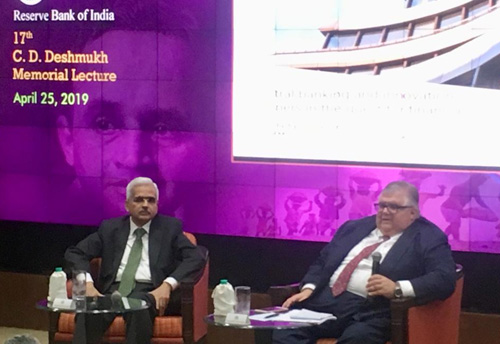Main barriers to Financial Inclusion are lack of trust, high costs of financial services & lack of documentations: Agustín Carstenss
Updated: Apr 26, 2019 09:55:47am

Main barriers to Financial Inclusion are lack of trust, high costs of financial services & lack of documentations: Agustín Carstenss
Mumbai, Apr 26 (KNN) Credit from within the formal financial sector is typically cheaper and has better terms than informal credit, with all the problems arising from lender oligopolies and doubts about creditworthiness, said Agustín Carstenss, General Manager, Bank for International Settlements (BIS).
He was addressing on the topic ‘Central Banking and Innovation: Partners in the Quest for Financial Inclusion’ at the seventeenth C.D. Deshmukh Memorial Lecture here on Thursday.
Speaking upon why is financial inclusion important, Carstens said financial inclusion provides access to financial services that are the key to participating in a modern economy. These include payments, credit, insurance and savings. Without access to efficient payment systems, business grinds to a halt.
A modern economy cannot work without efficient, reliable and cost-effective payments.
Credit allows resources to be used more optimally over time. Credit from within the formal financial sector is typically cheaper and has better terms than informal credit, with all the problems arising from lender oligopolies and doubts about creditworthiness, he opined.
Carstens said in credit markets that are subject to such problems, market power can become entrenched. Black market lenders often run as monopolies and charge exorbitant interest rates. Informal markets are also incapable of providing insurance products, which can serve as a cushion against shocks such as bad harvests, illness, or the death of the main wage earner.
Formal savings facilities can help generate low-risk interest income. Combined with formal credit facilities, they can help reduce fluctuations in consumer spending driven by income shocks. The poor stand to gain most from increased income stability and access to credit, the BIS General Manager highlighted.
While financial access does not guarantee financial engagement, it acts as an incentive. A basic deposit account opens the door to trying out other banking services, such as payments and credit.
Furthermore, financial inclusion fosters “social inclusion”. For example, by depositing savings in a current account, individuals are protected by property rights. If they put their savings into jewellery or just stash money under the mattress, they may fall victim to theft or devaluations.
Moreover, financial inclusion can make the transfer of welfare benefits faster, cheaper, and less prone to leakage. This benefits the state as well as the recipients. Overall, inclusion can help reduce poverty, Carstens noted deliberating the lecture.
He said the main barriers to inclusion are - “lack of trust” in the financial system, and particularly in money and financial institutions; “high costs” that is, a financial service may be too expensive for some users; and “lack of documentation” and the bank accounts cannot be opened without basic documents such as a birth certificate or identity card. Meanwhile, a blank credit record can block access to loans or insurance.
He. However, further said that the public policy and innovation can help to overcome these barriers. I will start with how central banks and financial authorities can increase trust in the financial system.
He said the central banks and financial authorities can support and promote financial inclusion, first and foremost, by pursuing their core objectives. By watching over price stability, they ensure that money keeps its value. By ensuring financial stability, they prevent financial institutions from failing, and taking people’s savings with them. But most of all, central banks promote trust. By reinforcing trust in the financial system and its institutions, central banks bring ordinary people into the mainstream and help them reap its benefits. In this way, the central bank can help to catalyse a more inclusive and vibrant economy.
“It is thus a necessary condition for financial inclusion that central banks fulfil their core mandates. Yet it is not sufficient. Other elements too are important. New technology can play a crucial role in breaking down barriers for both citizens and financial institutions,” he said.
He said Policymakers can play a vital role here by upgrading or providing new infrastructure, both hard and soft.
Citing example of UPI Payment, he said, “Take India’s Unified Payments Interface: this facility allows both domestic and global players to develop mobile payment applications. As such, it lowers the barriers to entry, especially for smaller firms, thus levelling the playing field.”
In his concluding remarks, Carnsten said, “Financial inclusion is the gateway to increased prosperity. Central banks play a key role simply by fulfilling their price and financial stability objectives. At the same time, innovation and technology are needed too.
Because financial innovation can have adverse effects too, it must be guided as well as supported,” he added. (KNN Bureau)











